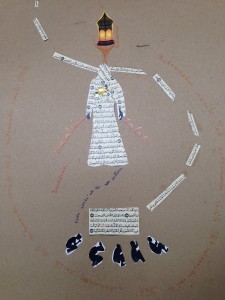


Reading: Infidel of Love: Exploring Muslim Understandings of Islam Chapter Three
I decided to illustrate in my art project the different roles the Prophet Muhammad plays in various Islamic communities. Professor Asani focuses in his book on 4 ways Muhammad is perceived in Islamic cultures: as a Prophet and messenger from God, as a role model, as an intercessor and finally as God’s beloved.
First of all, Muhammad is seen as God’s prophet: he plays a key role in defining the boundaries of faith in the Islamic tradition. Indeed, in the profession of faith, the shahadah, the first part is inclusive and is common to all monotheist religions (There is no God but God) whereas the second part of the shahadah, “muhammadur rasulu Ilah” (Muhammad is the Messenger of God) is exclusive and thus differentiates Islam from other religions. Muhammad is thus an important marker of Muslims’ identity, as reflected by the shahadah. On my project, you can see Muhammad standing at the center of the picture, under a yellow light (symbol of God) and inside with his followers of a circle made of the second sentence “muhammadur rasulu Ilah”.
Muhammad is also perceived as God’s messenger. Professor Asani writes that some Muslims consider Muhammad not to be the author of the Qur’an but rather “its transmitter” , like a “transistor radio”. This idea is reflected in the picture by a line made out of verses of the Qur’an which goes directly from the light at the top (which represent God who possesses the Holy Scriptures) to the Prophet’s ears and then from his mouth to the written Qur’an given to his followers, the Muslims.
In Chapter three, we can also read that Aisha, one of the Prophet’s wife, described him as being the “Walking Qur’an”. For a lot of Muslims, Muhammad represents a model, “uswa hasana”, and example to follow in order to access God and Heaven; he incarnates the right “path”. For this reason, a lot of Muslims believe in the importance of living as the Prophet did, according to his customs. I tried to represent these ideas by filling the body of the Prophet with verses of the Qur’an (he embodies the sacred text (“walking Qur’an”). I also draw flowing out from his hands Muslim customs such as the salat, the musulmani (act of circumcision for boys in South Asia, which means becoming a Muslim) or the Sunnah that are presented by Professor Asani as examples of rituals “determined by Muhammad’s reported practices”.
On top of being a role model, Muhammad is also a beloved intercessor between God and the rest of the believers (as reflected on the art project). Professor Asani describes that Muslims sometimes perceive Muhammad as both a “revered eleder in the family”, the one to turn to in times of “grief and difficulty”, and a prophet with the “ability to seek God’s mercy” for their sins. Thus, it is also a common custom for pious Muslims to pray for “God’s blessing upon Muhammad” by reciting the “tasliya” (prayer for the Prophet).
Finally, Muhammad became with time a mystic and was hold by Muslims as God’s beloved. For instance, Professor Asani talks about the association of Muhammad to a “form of light mysticism”, supported by the Light verse from which derives the idea of “Nur Muhammad” (the Muhammadan/Shining Light), of a Prophetic and Divine Light which was passed down from prophet to prophet since Adam up to Muhammad in who it found its ultimate completion. On the project, I decided to represent this Prophetic Light by a rope linking him to the the Lamp which then became one of the Prophet’s symbols.
Recent Comments